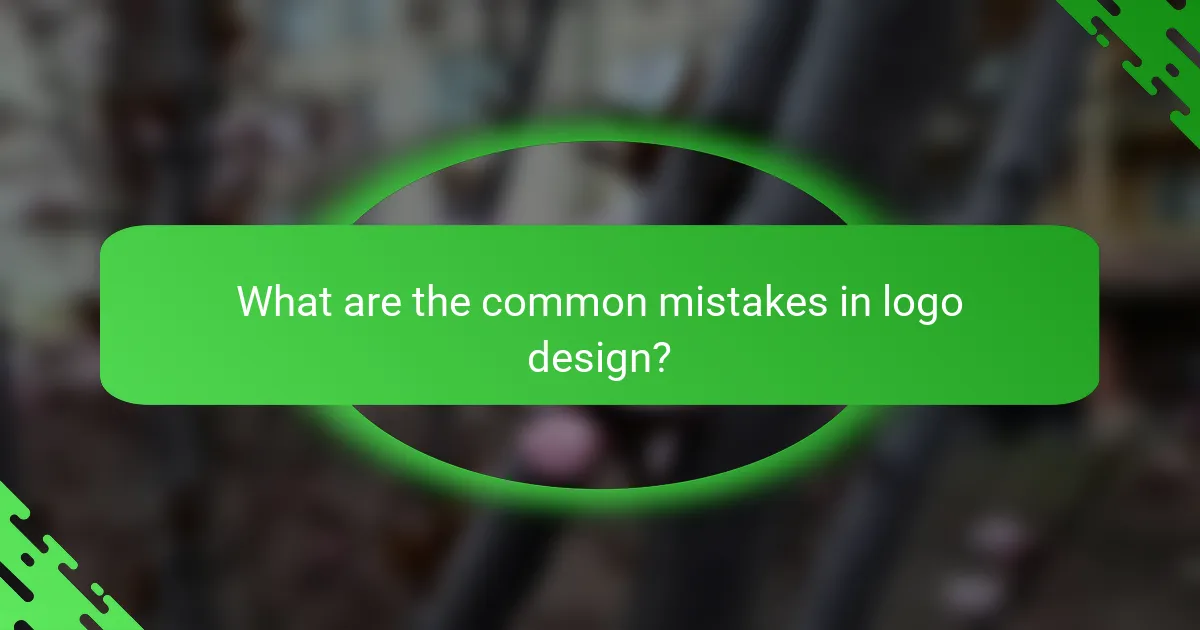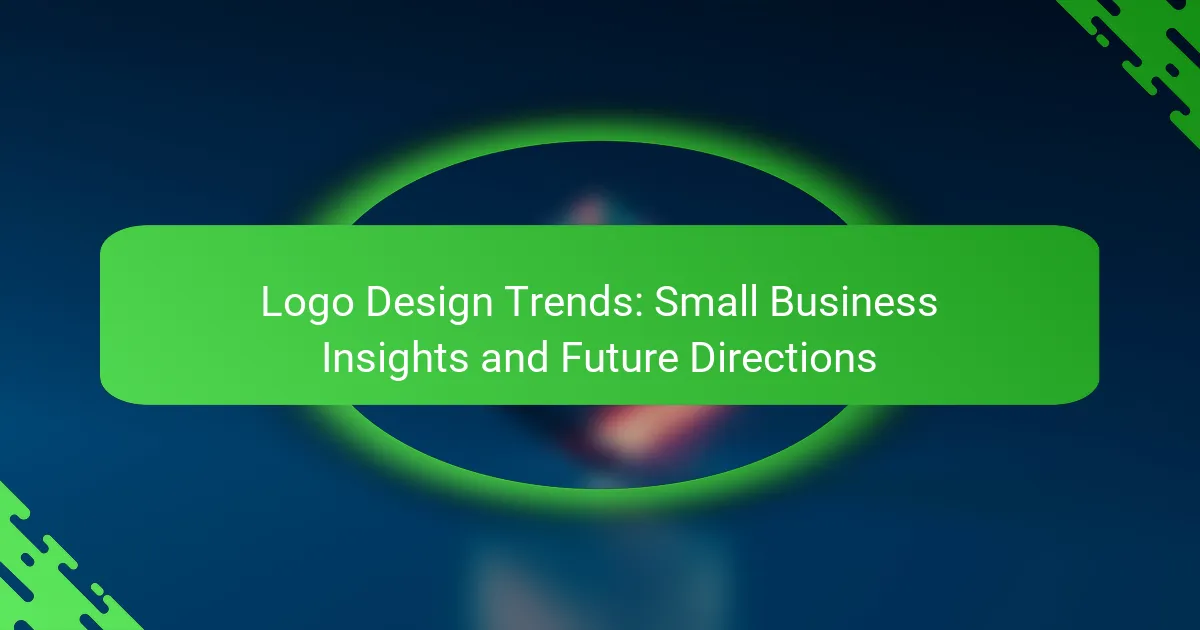In today’s competitive market, small businesses are increasingly adopting logo design trends that prioritize simplicity, boldness, and adaptability. By aligning their logos with brand identity and understanding their target audience, these businesses can create memorable visuals that resonate with customers. With a variety of accessible design tools available, entrepreneurs can craft professional logos that effectively communicate their brand’s essence.

What are the current logo design trends for small businesses?
Current logo design trends for small businesses emphasize simplicity, boldness, and adaptability. These trends help brands stand out while remaining relevant and appealing to their target audience.
Minimalist designs
Minimalist designs focus on simplicity and clarity, using fewer elements to convey a brand’s message. This approach often features clean lines, ample white space, and limited color palettes, making logos easily recognizable and versatile across various platforms.
Small businesses can benefit from minimalist logos by ensuring their branding is straightforward and memorable. Consider using one or two colors and a simple icon that represents your business effectively.
Bold typography
Bold typography is a trend that emphasizes strong, eye-catching fonts to create a memorable brand identity. This style often involves using large, thick letters that command attention and convey confidence.
When selecting bold typography, ensure it aligns with your brand’s personality. For instance, a playful business might choose a rounded, fun font, while a more serious enterprise may opt for a strong, sans-serif typeface.
Dynamic logos
Dynamic logos are adaptable designs that can change based on context, allowing for greater flexibility in branding. This trend can involve variations in color, shape, or even animation, making the logo more engaging and relevant to different audiences.
Small businesses can implement dynamic logos by creating variations for specific campaigns or seasonal promotions. However, ensure that the core elements remain recognizable to maintain brand consistency.
Eco-friendly branding
Eco-friendly branding focuses on sustainability and environmental consciousness, reflecting a growing consumer preference for responsible businesses. Logos in this trend often incorporate natural elements, earthy colors, and symbols associated with sustainability.
To adopt eco-friendly branding, consider using recycled materials for physical branding items and selecting colors that evoke nature. This approach can resonate well with environmentally conscious consumers and enhance your brand’s reputation.
Geometric shapes
Geometric shapes are increasingly popular in logo design, offering a modern and structured aesthetic. These designs often use simple forms like circles, triangles, and squares to create visually appealing logos that convey stability and professionalism.
When using geometric shapes, aim for a balance between creativity and simplicity. Experiment with combinations of shapes to form unique logos that still communicate your brand’s essence clearly.

How can small businesses choose the right logo design?
Small businesses can choose the right logo design by aligning it with their brand identity, understanding their target audience, and ensuring versatility across various applications. A well-designed logo should communicate the essence of the business while appealing to potential customers.
Understand brand identity
Brand identity encompasses the values, mission, and personality of a business. A logo should reflect these elements to create a cohesive image that resonates with customers. For instance, a tech startup might opt for a modern, sleek design, while a local bakery may choose a warm, inviting style.
To clarify your brand identity, consider creating a mood board that includes colors, fonts, and imagery that represent your business. This visual guide can serve as a foundation for your logo design process.
Consider target audience
Understanding your target audience is crucial in logo design. The logo should appeal to the demographic you aim to attract, taking into account their preferences and cultural references. For example, a logo aimed at young adults might use bold colors and trendy fonts, while one targeting seniors may prioritize readability and classic design elements.
Conducting surveys or focus groups can provide valuable insights into what resonates with your audience. This feedback can guide your design choices, ensuring your logo effectively communicates with potential customers.
Evaluate design versatility
A versatile logo can adapt to various formats and sizes without losing its impact. It should look good on business cards, websites, merchandise, and social media platforms. Consider how your logo will appear in both color and black-and-white, as well as in different sizes.
Test your logo in various contexts to ensure it maintains clarity and recognition. A good practice is to create mockups of your logo on different materials and backgrounds to see how it performs in real-world applications.

What tools can small businesses use for logo design?
Small businesses can utilize various tools for logo design, ranging from user-friendly platforms to advanced software. These tools cater to different skill levels and budgets, allowing entrepreneurs to create professional logos that reflect their brand identity.
Canva for beginners
Canva is an ideal choice for beginners due to its intuitive interface and extensive library of templates. Users can easily customize designs by adjusting colors, fonts, and layouts without needing graphic design experience.
To get started, simply sign up for a free account, choose a logo template, and modify it to fit your brand. Canva offers both free and premium elements, with costs typically ranging from a few dollars to around $15 for individual assets.
Adobe Illustrator for professionals
Adobe Illustrator is a powerful tool favored by professional designers for its advanced features and precision. It allows for vector-based design, ensuring logos remain sharp at any size, which is crucial for branding across various platforms.
While Illustrator has a steeper learning curve, it offers extensive resources and tutorials. Subscription costs for Adobe Creative Cloud start at approximately $20 per month, making it a worthwhile investment for serious small business owners.
Looka for AI-generated logos
Looka leverages artificial intelligence to generate logos based on user preferences, making it a quick and innovative option for small businesses. Users input their brand name, select styles, and the AI produces several logo designs to choose from.
Looka’s pricing starts at around $20 for basic logo files, with additional costs for branding packages. This tool is particularly useful for those who need a logo quickly and want to explore creative options without extensive design skills.

What are the costs associated with logo design?
The costs of logo design can vary significantly based on the designer’s experience, the complexity of the project, and the chosen design method. Small businesses should consider their budget and the value a well-designed logo can bring to their brand identity.
Freelancer rates
Freelance logo designers typically charge between $100 and $2,500, depending on their experience and the project’s scope. Newer designers may offer lower rates, while established professionals can command higher fees due to their portfolio and expertise.
When hiring a freelancer, review their previous work and client feedback to ensure they align with your vision. Consider negotiating a fixed price for the project to avoid unexpected costs.
Design agency pricing
Design agencies often provide a more comprehensive service, with logo design costs ranging from $2,500 to $50,000 or more. This higher price reflects the agency’s resources, including a team of designers and additional services like brand strategy and market research.
Choosing an agency can be beneficial for small businesses looking for a complete branding package. However, ensure you understand what is included in the price, such as revisions and deliverables, to avoid overspending.
DIY design costs
Creating a logo yourself can be a cost-effective option, with expenses typically ranging from free to a few hundred dollars for software or tools. Online platforms like Canva or Adobe Spark offer user-friendly interfaces and templates that can help you design a professional-looking logo.
While DIY design saves money, it requires time and effort to learn the tools and create a unique logo. Be cautious of using templates that may lead to similar logos among competitors, which can dilute your brand identity.

What are the common mistakes in logo design?
Common mistakes in logo design include overcomplicating the design, neglecting scalability, and failing to consider the target audience. These errors can lead to logos that are ineffective, unmemorable, or even off-putting to potential customers.
Overcomplicating the Design
One major mistake is creating a logo that is too intricate or detailed. A complex logo can be difficult to recognize and reproduce, especially in smaller sizes. Aim for simplicity; logos that are clean and straightforward tend to be more memorable and versatile.
For example, consider logos like Apple or Nike, which use minimalistic designs that are easily identifiable. A good rule of thumb is to limit the number of colors and elements to ensure clarity and impact.
Neglecting Scalability
Another common error is not considering how the logo will appear at different sizes. A logo must be effective on both large formats, like billboards, and small formats, such as business cards or social media icons. Test your logo at various sizes to ensure it remains legible and visually appealing.
Using vector graphics can help maintain quality across different sizes. This approach allows for resizing without loss of clarity, making your logo adaptable for various applications.
Failing to Consider the Target Audience
Designing a logo without understanding the target audience can lead to a disconnect between the brand and its customers. It’s crucial to research and identify the preferences and values of your target demographic. A logo that resonates with the audience can enhance brand loyalty and recognition.
For instance, a logo aimed at a youthful audience might incorporate vibrant colors and modern fonts, while a logo for a luxury brand may favor classic typography and a subdued color palette. Tailoring your design to the audience’s expectations is essential for effective branding.



